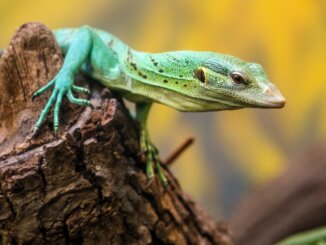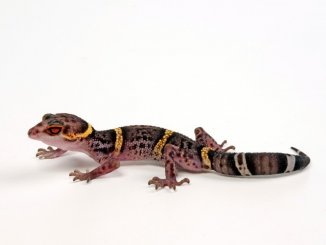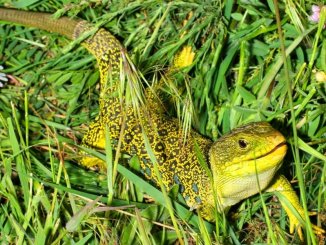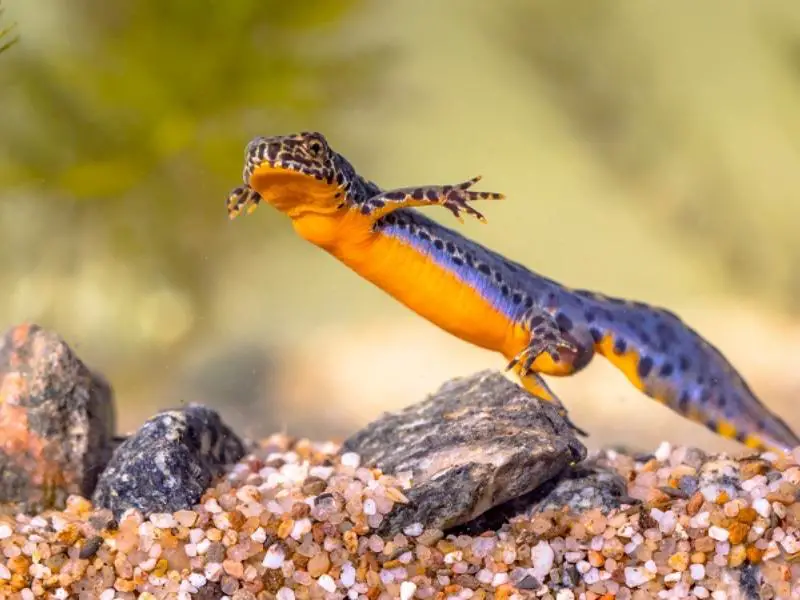
The alpine newt is a medium-sized species of newt endemic to continental Europe. Alpine newts are known for their striking orange bellies, hardy natures, and captivating behaviors. This species is semi-aquatic and lives for up to 20 years.
The alpine newt is relatively easy to care for, though it shouldn’t be handled and needs a tank setup that reflects its wild habitat.
Rankin’s Dragon Overview
| Common name | Alpine newt |
| Scientific name | Ichthyosaura alpestris |
| Natural habitat | Continental Europe |
| Adult size | Up to 4.7 inches |
| Average lifespan | 15 to 20 years |
| Diet | Carnivore |
| Housing | 50-gallon tank, semi-aquatic setup, hiding spots, artificial foliage, 57–71°F, natural light with complete darkness in evening |
| Experience | Beginner |
Origin
Alpine newts (Ichthyosaura alpestris) are native to continental Europe, where they reside in forested land habitats near small, cool bodies of water.
Wild alpine newt populations are slowly on the decline because of pollution, diseases, and habitat loss. However, these amphibians are still relatively common and aren’t considered endangered.
Alpine newts were formerly classified under the genus name Mesotriton, but now belong to Ichthyosaura. Alpine newts were first discovered in 1768 by Austrian zoologist Laurenti.
The scientific name, Ichthyosaura alpestris, is based on the nymph creature from Greek mythology.
Appearance and Behavior
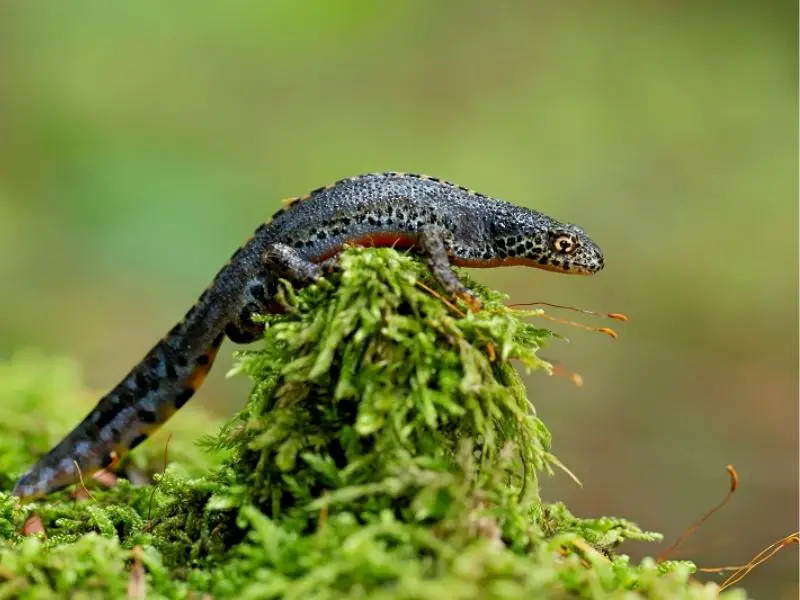
The alpine newt is a medium-sized newt with velvety skin, a stocky, dark gray body, and short, laterally compressed tail. These amphibians are particularly well known for their vibrant orange bellies and piercing eyes.
Alpine newts are sexually dimorphic, meaning males and females are easy to tell apart. Males are smaller than females, and also have a smooth, yellowish-white crest that becomes prominent in breeding season. Females have a darker, dorsal color.
Juveniles are similar in appearance to adults, though often have a dark red or yellow stripe across their back.
There are several recognized subspecies of alpine newts. The ones most commonly kept in captivity include:
- I.a. apuanus:: Distributed across Italy, Denmark, Belgium, Germany, Greece, Russia, Holland, Luxembourg, and Ukraine. Max size up to 4.5 inches
- I.a. alpestris: Found throughout southwest France and northern Italy. Max size up to 4 inches and typically has a spotted belly
- I.a. cyreni: Native to the Cantabrian Mountains in Spain. Has a larger, bulkier head and more rounded stature than other subspecies
Alpine newts closely resemble great crested newts (Triturus cristatus), though alpine newts are slightly smaller in size.
Size and Lifespan
The alpine newt is considered medium sized, with a maximum tail-to-head length of 4.7 inches and weight between 1.4 and 6.4 grams. Females are up to 0.79 inches longer than males.
Alpine newts have an average life expectancy of 15 to 20 years, though can live for up to 30 years in the wild at high altitude. Provide a varied, protein-rich diet, ideal enclosure conditions, and plenty of hiding spots to help these newts live long, fulfilling lives.
Temperament
The alpine newt is an even-tempered, shy species that’s most active at night (nocturnal). During the day, the amphibian spends most of its time hiding in burrows or among leaf litter.
When threatened, alpine newts either flee or assume a defensive pose that exposes their bellies. The vibrant belly color functions as a warning signal and helps ward off predators. Alpine newts can also secrete toxins through their skin.
While aggression is rare, alpine newts shouldn’t be handled because it can cause stress and affect their protective, mucus coating. These amphibians are also known to harbor harmful chytrid fungus, such as Batrachochytrium dendrobatidis.
Alpine newts can be housed together, as long as the enclosure is spacious and females outnumber males. Keeping more than one male in the tank encourages breeding.
Housing Alpine Newts
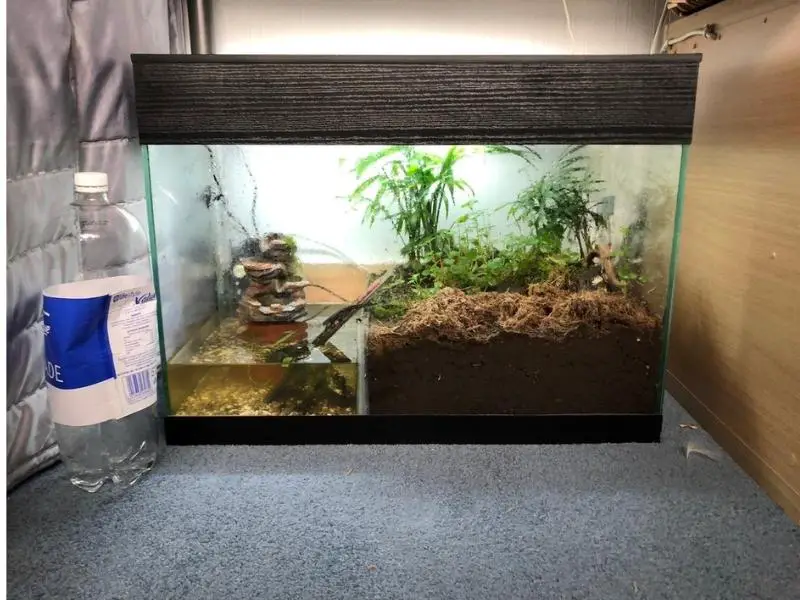
In the wild, alpine newts are found in forested areas with small bodies of cool water, such as puddles, ponds, and lakes. These newts are usually terrestrial (ground-dwelling), but migrate to water during the breeding season.
Replicate the alpine newt’s wild habitat in the enclosure to help it feel comfortable and secure. This species should be kept in a tank with a secure lid.
Enclosure Size
Alpine newts require a 50-gallon tank or larger, with enough length to establish an aquatic side and terrestrial side. The tank should also be tall enough to accommodate a water depth of 15 inches.
Lighting
Alpine newts are a nocturnal species and don’t benefit from UVB lighting. The tank should be positioned in an area that receives natural sunlight, though never in direct sunlight. In the evening, keep the aquarium in total darkness to replicate a natural day-to-night cycle.
Temperature
The alpine newt does best in cool temperatures, ideally between 57 and 71°F. Keep the tank temperature low with air conditioning, an aquarium chiller, or performing partial water changes with cool water. Hobbyists can also move the tank to a cold spot in the house.
Monitor the temperature daily with a thermometer to minimize fluctuations. The tank should never exceed 84°F — an improper temperature level can cause significant distress and lead to health complications.
Substrate and Decoration
Simulate the alpine newt’s wild habitat in the tank with an equal split of land and water. The water source should be at a neutral pH, 15 to 20 inches deep, and have a fine sand or gravel substrate. Also ensure the alpine newt can easily get in and out of the water. Use decorations, such as coralwood or bark, to create a bridge-like structure if necessary.
Add a high-quality undergravel filtration system that won’t generate a strong current or put the newt in harm’s way.
The land side of the tank should have a substrate of sloping slate or a mix of soil and leaf litter. Add hiding spots with artificial foliage, logs, caves, branches, and plant pots.
Ensure the tank has a secure lid because alpine newts are known to sometimes climb. Decorations must be sturdy, non-abrasive, and well-sanitized.
Cleaning
Perform a partial water change, around 20 to 30%, once a week to maintain clean conditions. Spot clean the tank regularly to remove waste, leftover food, or other detritus, even with the filter.
Perform a deep clean on a monthly basis, which involves wiping down the glass and decorations with warm water. Avoid using harsh chemical products as alpine newts are extremely sensitive.
Decorations should be sanitized before being introduced into the enclosure. Soak in a solution of one part cleaning solution and nine parts hot water. Thoroughly rinse and leave to dry, making sure there are no traces of cleaning solution leftover.
Alpine Newt Care
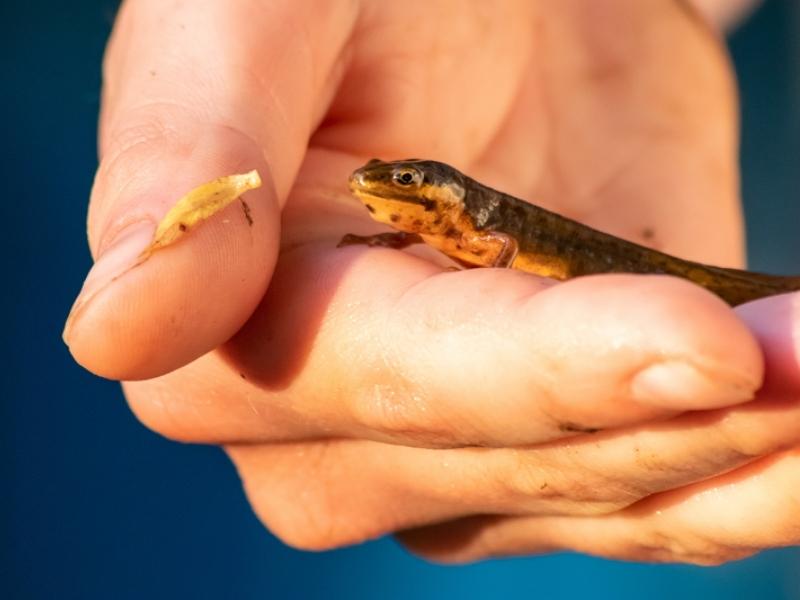
The alpine newt is easy to care for because of its small size, hardy nature, and unfussy eating habits. However, this species can harbor chytrid fungus.
Food and Water
Alpine newts are carnivores with voracious appetites. In the wild, these amphibians feed on gastropods, crustaceans, and springtails.
Captive alpine newts should be fed a varied, protein-rich diet consisting of foods such as slugs, sliced earthworms, bloodworms, daphnia, crickets, and the occasional waxworm.
Feed adult alpine newts two to three times a week, offering food at night to replicate their nocturnal eating habits. Give these newts only as much food as they can eat within one sitting.
Common Health Issues
Alpine newts are hardy and can live for up to 20 years with proper care. However, improper tank conditions — or buying from an irresponsible breeder — can make these amphibians particularly susceptible to Chytridiomycosis.
Chytridiomycosis is an infectious, potentially life-threatening disease caused by two types of chytrid fungus (Batrachochytrium dendrobatidis (Bd) and B. salamandrivorans (Bsal). Symptoms include sluggishness, skin changes, ulcerations, abnormal behavior, and excessive shedding, though infected amphibian species are sometimes asymptomatic.
Treatment involves antifungal medication. Alpine newts are known carriers of chytrid fungi, and while relatively tolerant of this disease, can pass it on to other amphibians in the tank. Always quarantine new arrivals.
Shedding
The alpine newt sheds as frequently as once a week while it’s growing. A healthy shed is thin, translucent, and falls off in one piece. A shed that gets stuck — or comes off in flakes — can indicate sickness, especially if the newt is exhibiting abnormal behavior.
The shedding process typically goes unnoticed because alpine newts often eat the excess skin.
Breeding
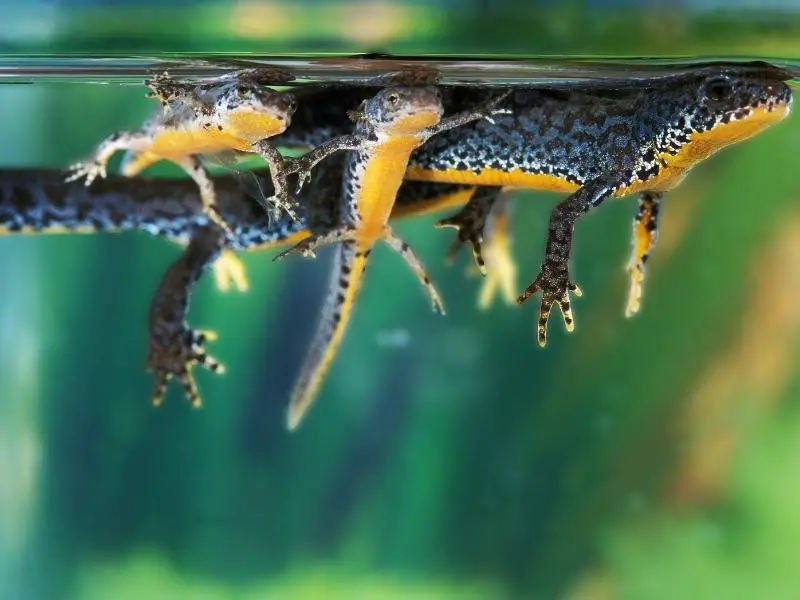
Alpine newts reach sexual maturity at two to three years and breed readily if kept in pairs. However, they must first undergo hibernation during winter. Induce hibernation by gradually lowering the tank’s temperature down to 41°F. Then, after a few months, slowly raise the temperature back to its normal range. Keep the humidity level in the tank high.
When a male is interested in mating, he will deposit a spermatophore (sperm package) and exhibit various courting behaviors, including tail fanning, flank touching, and positioning to increase his crest height. A receptive female will follow the male and take in the spermatophore through her cloaca.
After mating, the female will begin to lay eggs in the water, typically among water plants, and continue to do so for up to three months. Most alpine newts lay 30 to 500 eggs in total, which hatch within a month.
Alpine newt larvae are small and born with gills. Larvae should be fed smaller foods, such as newly-hatched brine shrimp, at a feeding schedule of twice per day.
Choosing and Buying an Alpine Newt
Alpine newts typically cost between $40 and $100. While uncommon in local pet stores, the species is readily available online, in exotic pet stores, and at amphibian expos. There’s also plenty of reputable breeders across the world.
While the initial cost is low, caring for an alpine newt is relatively expensive because of this species’ long lifespan. Avoid wild-caught newts as they’re prone to health issues and often struggle to acclimatize to captive conditions.
Never release captive alpine newts into the wild because they can transmit life-threatening diseases. Several places also have legislation in place that makes doing so a criminal offense, such as the United Kingdom’s Wildlife and Countryside Act 1981.

